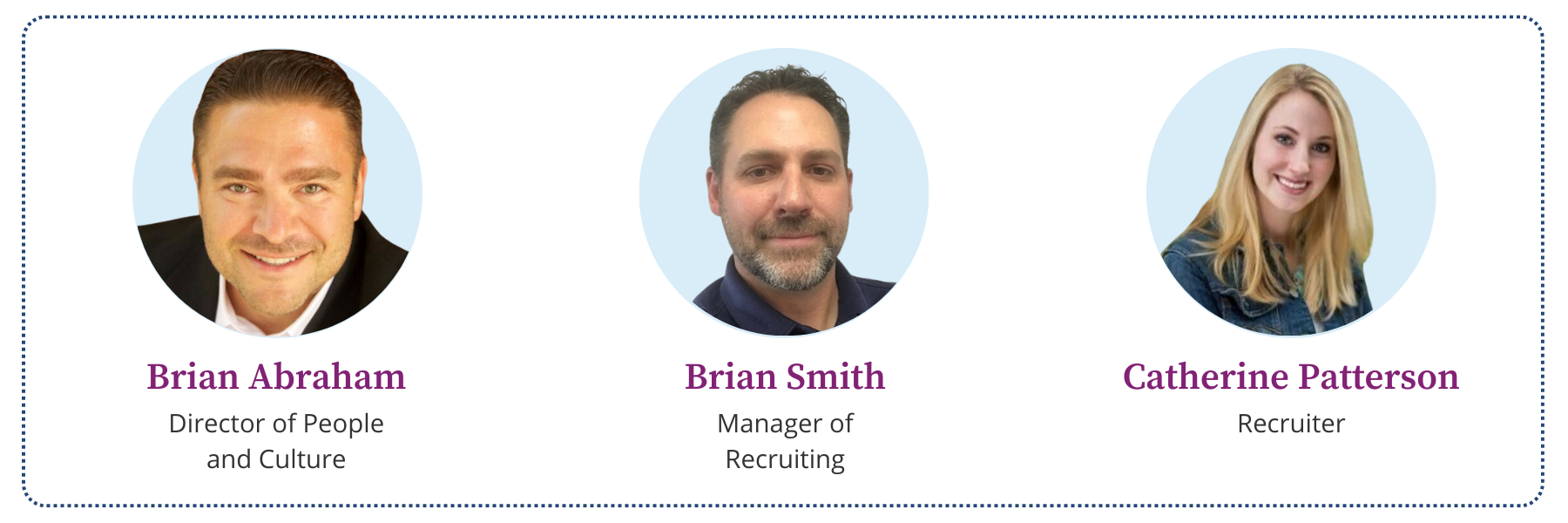In recent months, layoffs — mainly at tech companies, but also in finance and retail — have dominated headlines. At the same time, unemployment is nearing historic lows and hiring is “robust” in plenty of market sectors, including leisure and hospitality and construction. Whether your industry’s job market is slow now or you’re preparing for future downtime, how can your recruiters make the most of hiring freezes or seasonal fluctuations?
We spoke with ClearCompany’s Talent Acquisition team and got their expert advice on how recruiters can use downtime to work on high-impact, high-visibility projects that can fall by the wayside in busier seasons. First, meet the team:
Now, let’s dig into five tips from the experts on how to refine recruitment practices during a hiring freeze or slow hiring season.
Get 5 tips from @ClearCompany expert recruiters on how to add value during slow hiring seasons:1. Update Employer Branding
The impact of employer branding is bigger than you might think — it’s what convinces potential candidates to throw their hats in the ring. Your employer brand showcases your company culture, mission, and values, and presents your employee value proposition (EVP), giving applicants a glimpse into the benefits of working at your company.
Though it may not seem critical to have a consistent employer brand, said Director of People and Culture Brian Abraham, it is. He recommends prioritizing updates to employer brand when your team has the time, like during slow hiring seasons. A strong employer brand includes consistency in your messaging across job descriptions, social media, and your career site.
“Even if you can't take the time to do your employer brand, upgrade your job descriptions to be consistent in voice and consistent in format because consistency creates trust,” said Abraham.
Abraham also recommends asking for employee feedback to find out what about the employer brand and hiring process drew them in, what was missing, and what sets your company apart. Conduct stay interviews with current employees to get this insight.
“You can get so much out of interviewing top performers and finding out what they like, not just for your employer brand, but also for your career site redesign. What information can we provide that we're not already providing and that other companies don't?” Abraham said. “That’s where you're giving that differentiation; that EVP — why you should work here versus everywhere else.”
2. Refresh Text and Email Templates
“When we’re really busy, it’s hard to slow down and actually update email and texting templates,” said Recruiter Catherine Patterson, so take advantage of slower hiring seasons to update your recruiting text message and email templates.
Using templates when messaging candidates is an effective recruiting strategy, personalizing communications while promoting consistency with your employer brand. But if you’ve been using the same messages for years, or you recently updated employer branding, it may be time to refresh your templates to align with your employer brand messaging or collaborate with your team to create new ones.
3. Evaluate Your Recruiting Software
If you use recruiting software, Patterson advised, “Make sure that you're utilizing all of those tools within whatever system you have” to ensure you’re getting the most from your solution. If you’re underutilizing your system or in need of features it doesn’t have, you might also consider whether it’s time to upgrade your applicant tracking system (ATS).
This process takes a while, sometimes weeks or even months, and it’s hard to make time for it when there are lots of requisitions to fill. When hiring is slow or on hold, use the extra time to evaluate your current software and whether or not it’s working for your team. If you’re due for an upgrade, you can start researching and vetting new providers.
Look for time-saving features that benefit your recruiting team, including:
- Job board management and posting
- Candidate texting tools like templates and bulk texting
- One-click background checks
- Easy interview scheduling and automatic virtual interview links
Get more tips for buying new software — check out our ATS Buyer’s Guide.
@ClearCompany expert recruiters share 5 tips for how #recruiters can make the most of slow hiring seasons:4. Gather Competitive Intelligence to Improve Candidate Experience
When hiring slows, you have the opportunity to look into what other companies are doing to attract potential employees to improve your own candidate experience. What information can your recruiters provide that other recruiters don’t — or can’t — provide? What sets your EVP apart?
“Do competitive intel — research your competitors and how they market themselves. Maybe you're missing out on something that we could be advertising, something we do really well that our competitors are taking credit for,” said Brian Smith.
In addition to the stay interviews we mentioned, clients and candidates who weren’t hired can tell you a lot about how your employer brand and candidate experience are perceived.
“It's great to get internal points of view, but you should see what’s going on with external reviews, too,” said Smith. “Getting that insight from both sides is important — someone could leave feedback about an interview experience without actually being an employee.” Learn more about your brand reputation by reading customer reviews and checking out sites like Glassdoor.
5. Build Talent Pipelines
How to Talk to Your Talent Pool During a Hiring Freeze
It’s not a common occurrence, but sometimes, recruiters face hiring freezes. So how do you communicate to candidates and your talent pool? Be honest, our experts advise, and let them know these measures are taken to protect the company’s current employees and avoid layoffs.
At every company, some roles are harder to fill than others, and some have naturally higher turnover rates. In both cases, strong talent pipelines enable recruitment success when these roles need to be filled.
And there’s no need to reach out to these candidates just yet — building a pipeline just streamlines the recruitment process when hiring picks up. “By the time the role opens back up, you've already got a bunch of people you can reach out to right away,” said Abraham.
When candidates aren’t hired but may be a good fit for future roles, be sure to tag them in your recruiting software. That way, you’re compiling an engaged pool of top talent that’s easy to contact when the right roles open up.
If candidates do reach out when you’re not hiring, or ask what’s going on with a role that had to be put on hold, our experts advise being honest. Abraham tells these candidates, “We're doing it to protect our existing employees. We don't want to overspend, and we don't want to lay anybody off. Candidates really appreciate that.”
Slow hiring doesn’t mean talent acquisition teams can’t make an impact. If your company is in a slow hiring season or a hiring freeze or expects these in the future, we have the resources you need to make the most of that downtime.
In our Candidate Sourcing Guide, developed by Director of People and Culture, Brian Abraham, you’ll learn resilient recruiting strategies and get expert advice on how to evaluate your ATS options. Download the guide here.


